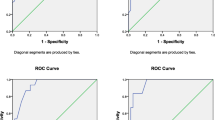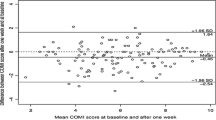Abstract
The Oswestry Disability Index (ODI) is one of the most widely used questionnaires that assess disability in patients with low back pain (LBP). Responsiveness is both an important psychometric property of an instrument and a key issue for clinicians when choosing suitable outcome measures. The objective of this study was to examine the responsiveness of the Chinese version of the ODI (ODI-Chinese) for subjects with chronic LBP following a physical therapy program. In total, 76 patients with chronic LBP completed the ODI-Chinese, a visual analog scale (VAS) of pain, and the Chinese version of Short Form-36 (SF-36) before and after treatment. All patients also completed a global perception of change Likert scale in condition after the program. The scale was collapsed to produce a dichotomous variable outcome, improved or non-improved. The responsiveness of the instruments was determined using the standardized response means (SRM) and receiver operating characteristics (ROC). After treatment, 56 patients considered themselves to be improved. The SRM of the ODI-Chinese was −1.2 in the improved group and −0.4 in the non-improved group. The area of the ROC curve for the ODI-Chinese was 0.77 (95% CI 0.66–0.89). Therefore, the Chinese version of the ODI is both responsive and appropriate for use in chronic LBP patients after conservative therapy.


Similar content being viewed by others
References
Beaton DE (2000) Understanding the relevance of measured change through studies of responsiveness. Spine 25:3192–3199 (PMID: 11124736)
Beurskens AJ, de Vet HC, Köke AJ (1996) Responsiveness of functional status in low back pain: a comparison of different instruments. Pain 65:71–76 (PMID: 8826492)
Coelho RA, Siqueira FB, Ferreira PH, Ferreira ML (2008) Responsiveness of the Brazilian-Portuguese version of the Oswestry Disability Index in subjects with low back pain. Eur Spine J 17:1101–1106. (PMID: 18512083). doi:10.1007/s00586-008-0690-1
Costa LO, Maher CG, Latimer J (2007) Self-report outcome measures for low back pain: searching for international cross-cultural adaptations. Spine 32:1028–1037 (PMID: 17450079)
Davidson M, Keating JL (2002) A comparison of five low back disability questionnaires: reliability and responsiveness. Phys Ther 82:8–24 (PMID: 11784274)
Deyo RA, Centor RM (1986) Assessing the responsiveness of functional scales to clinical change: an analogy to diagnostic test performance. J Chronic Dis 39:897–906 (PMID: 2947907)
Fairbank JC, Couper J, Davies JB, O’Brien JP (1980) The Oswestry low back pain questionnaire. Physiotherapy 66:271–273 (PMID: 6450426)
Fairbank JC, Pynsent PB (2000) The Oswestry Disability Index. Spine 25:2940–2952 (PMID: 11074683)
Frost H, Lamb SE, Stewart-Brown S (2008) Responsiveness of a patient specific outcome measure compared with the Oswestry Disability Index v2.1 and Roland and Morris Disability Questionnaire for patients with subacute and chronic low back pain. Spine 33:2450–2458 (PMID: 18824951)
Grotle M, Brox JI, Vøllestad NK (2004) Concurrent comparison of responsiveness in pain and functional status measurements used for patients with low back pain. Spine 29:E492–E501 (PMID: 15507789)
Guyatt GH, Berman LB, Townsend M, Taylor DW (1985) Should study subjects see their previous responses? J Chronic Dis 38:1003–1007 (PMID: 4066888)
Hashimoto H, Komagata M, Nakai O, Morishita M, Tokuhashi Y, Sano S, Nohara Y, Okajima Y (2006) Discriminative validity and responsiveness of the Oswestry Disability Index among Japanese outpatients with lumbar conditions. Eur Spine J 15:1645–1650. doi:10.1007/s00586-005-0022-7
Hägg O, Fritzell P, Nordwall A (2003) The clinical importance of changes in outcome scores after treatment for chronic low back pain. Eur Spine J 12:12–20. doi:10.1007/s00586-002-0464-0
Jin K, Sorock GS, Courtney T, Liang Y, Yao Z, Matz S, Ge L (2000) Risk factors for work-related low back pain in the People’s Republic of China. Int J Occup Environ Health 6:26–33 (PMID: 10637534)
Lauridsen HH, Hartvigsen J, Manniche C, Korsholm L, Grunnet-Nilsson N (2006) Responsiveness and minimal clinically important difference for pain and disability instruments in low back pain patients. BMC Musculoskelet Disord 7:82. doi:10.1186/1471-2474-7-82
Liu H, Tao H, Luo Z (2009) Validation of the simplified Chinese version of the Oswestry Disability Index. Spine 34:1211–1217 (PMID: 19444069)
Li L, Wang HM, Shen Y (2003) Chinese SF-36 Health Survey: translation, cultural adaptation, validation, and normalization. J Epidemiol Community Health 57:259–263 (PMID: 12646540)
Mannion AF, Junge A, Grob D, Dvorak J, Fairbank JC (2006) Development of a German version of the Oswestry Disability Index. Part 2. Sensitivity to change after spinal surgery. Eur Spine J 15:66–73. doi:10.1007/s00586-004-0816-z
Merkesdal S, Mau W (2005) Prediction of costs-of-illness in patients with low back pain undergoing orthopedic outpatient rehabilitation. Int J Rehabil Res 28:119–126 (PMID: 15900181)
Norman GR, Stratford P, Regehr G (1997) Methodological problems in the retrospective computation of responsiveness to change: the lesson of Cronbach. J Clin Epidemiol 50:869–879 (PMID: 9291871)
Ostelo RW, Deyo RA, Stratford P, Waddell G, Croft P, Von Korff M, Bouter LM, de Vet HC (2008) Interpreting change scores for pain and functional status in low back pain: towards international consensus regarding minimal important change. Spine 33:90–94 (PMID: 18165753)
Taylor SJ, Taylor AE, Foy MA, Fogg AJ (1999) Responsiveness of common outcome measures for patients with low back pain. Spine 24:1805–1812 (PMID: 10488511)
Vianin M (2008) Psychometric properties and clinical usefulness of the Oswestry Disability Index. J Chiropr Med 7:161–163 (PMID: 19646379)
Walsh TL, Hanscom B, Lurie JD, Weinstein JN (2003) Is a condition-specific instrument for patients with low back pain/leg symptoms really necessary? The responsiveness of the Oswestry Disability Index, MODEMS, and the SF-36. Spine 28:607–615 (PMID: 12642770)
Wells G, Beaton D, Shea B, Boers M, Simon L, Strand V, Brooks P, Tugwell P (2001) Minimal clinically important differences: review of methods. J Rheumatol 28:406–412 (PMID:11246688)
Acknowledgments
No benefits of any form have been received, or will be received from a commercial party related either directly or indirectly to the subjects of this article. No funds were received in support of this work.
Author information
Authors and Affiliations
Corresponding author
Rights and permissions
About this article
Cite this article
Ma, C., Wu, S., Xiao, L. et al. Responsiveness of the Chinese version of the Oswestry disability index in patients with chronic low back pain. Eur Spine J 20, 475–481 (2011). https://doi.org/10.1007/s00586-010-1624-2
Received:
Revised:
Accepted:
Published:
Issue Date:
DOI: https://doi.org/10.1007/s00586-010-1624-2




